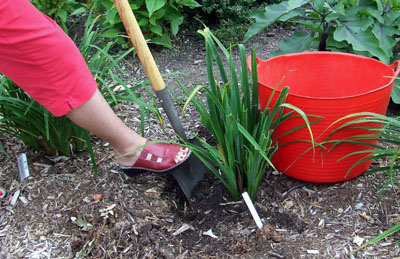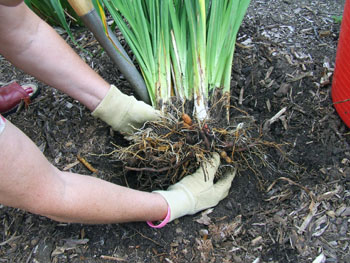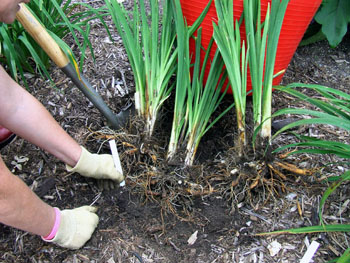Sharpen your shovel for late-summer garden chores
August and September are great times to start thinking about re-energizing your garden and preparing for the upcoming year by dividing and refurbishing your perennials.
August and September are often described as the “dog days” of summer, but to a perennial gardener, it is a great time to be thinking about re-energizing perennials like iris and daylilies for the coming year. Both known as long-lived perennials, these garden favorites often can use a “pick-me-up” as they age. Like the “old gray mare,” the woody crowns of a perennial may not be performing as well as it once was.
Out with the old in the iris bed
Many novice gardeners start out with bearded iris, and what’s not to love about this Mediterranean beauty? Elegantly shaped blooms have a furry “beard” running down the petals (referred to as sepals). Of the six sepals, three are turned up and three turned down, the latter commonly referred to as “falls.” Coming from the Greek, Iris was the goddess of the rainbow, which seems to correctly reflect the diversity in this genus.
Bearded iris benefits greatly from a plant propagating technique known as division. This surgery of sorts allows a gardener to lift and select firm, healthy rhizomes (underground stems) and to toss out the old ones. Simply dig up the whole iris clump and shake off the existing soil. You should be able to get a good look at the rhizome tissue and select for the newest, firm rhizomes with visible buds. The woody center pieces are generally darker and may show signs of iris borer activity leaving behind tell-tale pencil lead-sized holes. Discard the old, trim back the green leaves to a simple “fan” and reposition the new into the existing site or a new one.
Getting this chore done before the end of September will allow that new rhizome and fan to become well-established with small feeder roots that anchor it in the soil. If you do this chore later in the season, experts recommend placing a small rock on the rhizome throughout winter to avoid “heaving.”
Divide and conquer your daylilies
Daylilies are another garden favorite that responds well to division. Many daylily growers divide daylilies “any time the shovel is sharp,” according to the old adage. However, the best time is post-bloom and before the soil becomes so cold that new roots won’t establish. I find that September is a wonderful time for this job as well. If you trim back the foliage by half, the lifting of the clump is easier. Large clumps can be cut with a sharp spade into pie-shaped wedges or if the clump is loose, just hosing off soil with a stream of water will allow individual plants to be dislodged from the clump.

Dividing perennials like the daylily is easy. Start by lifting whole
clump and shaking off the soil.

Separate into pieces by hand or a sharp knife and remove dead
or mushy tissue.

Replant smaller (three to five fans) divisions at their original
depth into the new location and water well.
Post-planting care after division
It is best to water the newly planted divisions to displace soil air pockets that may create rot conditions over winter. If there is a dry fall, this will also get the plant off to a good start for next year. With ample rain, supplemental watering may not be a concern. Mulching the newly planted perennials with your own or commercial garden compost will supply a low amount of nutrients while evening out soil moisture. Next spring, follow up your planting efforts with fertilizer as recommended by a soil test.
Find out about other educational resources and classes at http://www.migarden.msu.edu and at Finneran’s blog. You can contact the MSU Master Gardener Lawn and Garden Hotline at 888-678-3464 with your questions.
Related Source:



 Print
Print Email
Email



